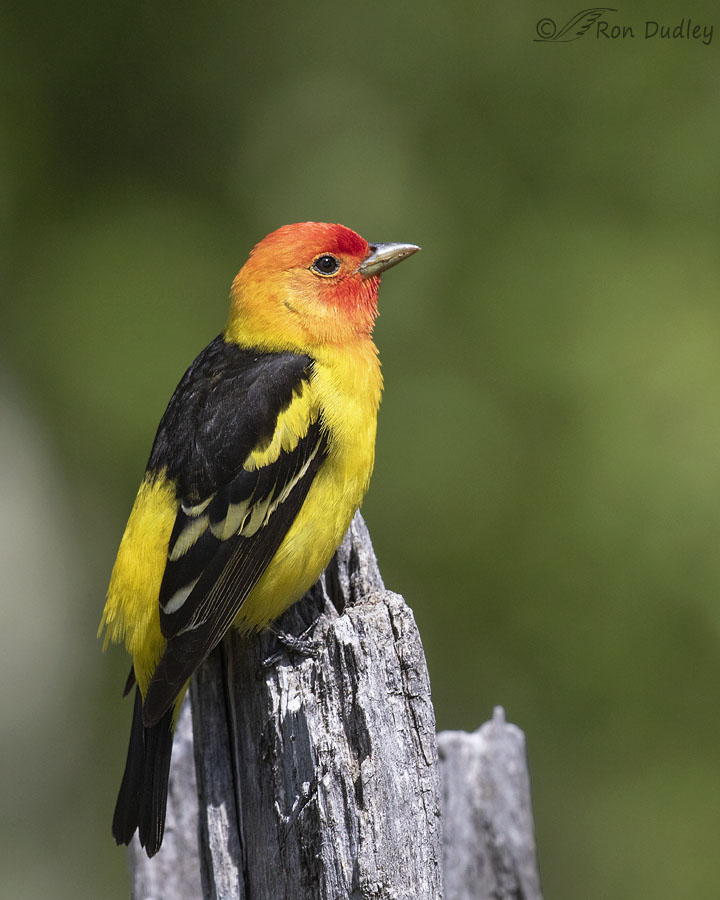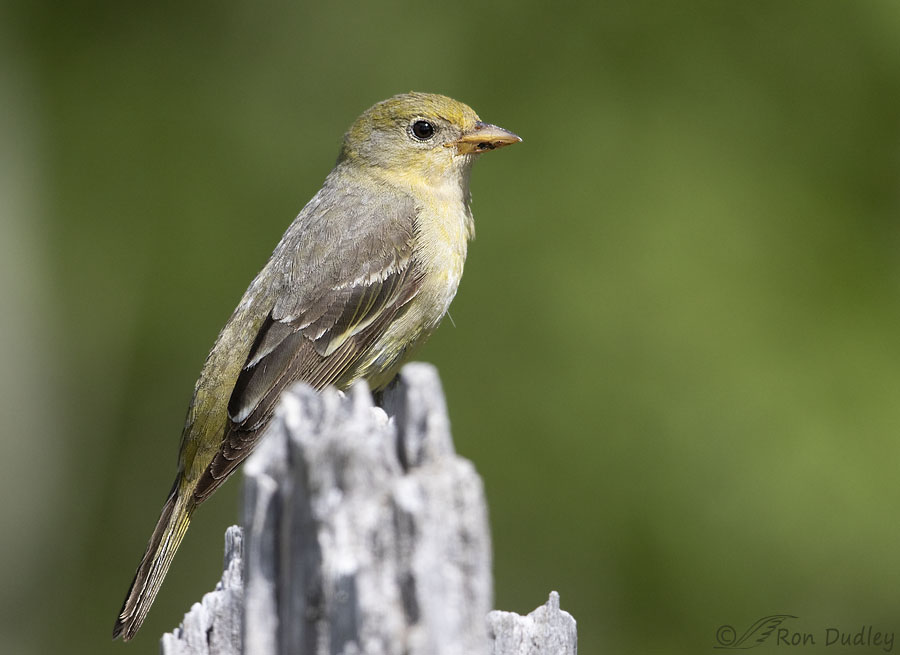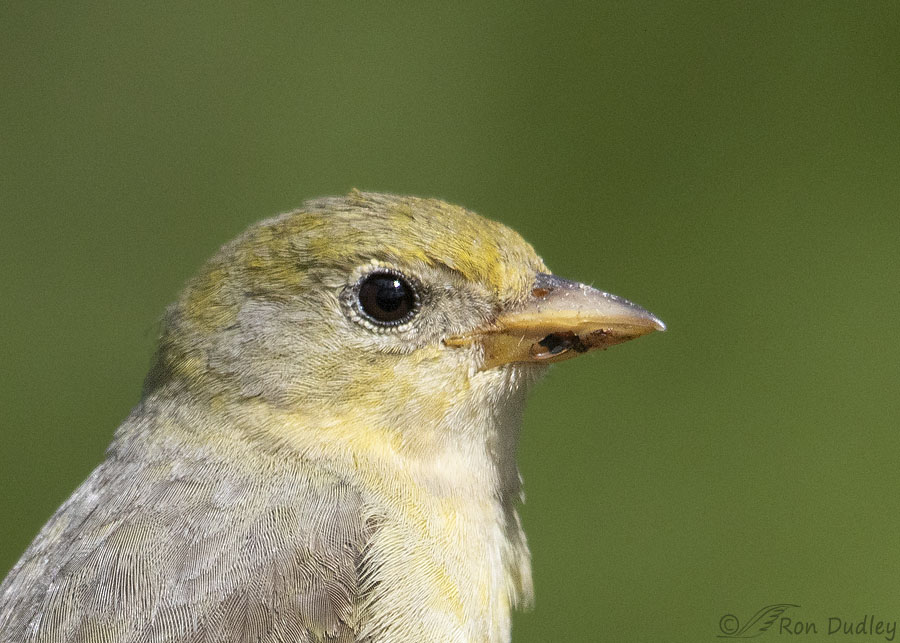Sometimes I find things that are disturbing when I finally get around to looking more closely at some of my photos. Thankfully it doesn’t happen very often but that doesn’t make it any easier when it occurs.

1/5000, f/6.3, ISO 800, Canon 7D Mark II, Canon EF 500mm f/4L IS II USM, not baited, set up or called in
This is the male of the apparently mated pair of Western Tanagers I photographed about three weeks ago on my camping trip to Idaho and Montana. He was “happy,” healthy and even cooperative as he flitted around my campsite in his never-ending search for insects.
I had positioned my camera on its tripod in anticipation of photographing him in the aspens that ringed my campsite but here he chose to land so close to me I had to remove my teleconverter and shoot vertically to keep all of him in frame. At that point I was learning that this old stump was among his favorite perches so I always positioned myself further away from the stump after that.

This photo of the female, his presumed mate, would normally never see the light of day because of its multiple major flaws (including a distractingly out of focus and contrasty perch and a soft bird) but I need it to tell my sad story.
In contrast to her mate this female was incredibly shy so I was never able to get any decent photos of her. But last night while I actually had my finger on the delete button to banish this photo to my trash bin I noticed something that caught my attention. Her lower mandible didn’t look right. At first I thought it was probably just debris on her bill but I decided to investigate and take a closer look.

I can’t be sure but it looks to me like she has a diseased lower mandible. In fact if I’m not mistaken I can see all the way through it to the other side.
At this point it didn’t seem to affect her feeding behavior. At least twice a saw her capture insects and consume them but I’m sure worried about her over the long haul. At the very least I hope she and her mate are able to raise their brood to fledging before things go really bad for her.
I’ll admit that sometimes I probably got too attached to “my” birds. It’s a tough world out there and things like this happen far more often than most of us realize. But I spent a lot of time with these tanagers over almost four days so discovering this anomaly in the female really stings.
If you have a heart it’s part of the human condition I guess. I sure hope I’m wrong but I’m not optimistic.
Ron
PS – I have a question I should have asked my readers about long ago. As a biologist I’m fully aware that the term “mandible” refers to the lower jawbone and “maxilla” refers to the upper jawbone in most vertebrates. But over the years I’ve noticed that in the “bird world” the terms “upper mandible” and “lower mandible” are usually (though not always) used for the upper and lower bills of birds and “maxilla” isn’t used at all.
If so, maybe it’s because bills aren’t bones but it doesn’t seem consistent so I have to wonder if it’s technically correct.
What say ye, Dan Gleason (or anyone else in the know, including rehabbers, etc)?


To me it almost looks like a hook. That would be horrible if so. Sweet little bird.
Hello Ron, my name is Tommy and i’m an 18 years old biology student and nature fanatic from Argentina! This article was really interesting and j found it via Google news, in case that you don’t know here in the country we have a immense variety of birds!
I really like birds and fish also, but don’t know yet what specialization I want to make in my future! I was wondering if you used instagram in order to make you a couple of questions!
Hope to hear from you soon
Ron, I have a friend in Canada who has rehabbed birds for many years. I asked her to look at your post and photos. She is very used to long-distance discussions of what might ail a feathered creature.
She considered a lesion, a scab or something other. She examined a mega-enlargment of the image of the beak with a magnifying lens. Her thoughts were as follows:
1. there is something odd, arced and pink, almost like a little toe with a talon, sticking out of the mass at the low left corner of it. To the right of it, at the low edge of the bill, there is a crumb and above it crumbs.
2. because of the crumbs and such I don’t lean toward a pox lesion and am not convinced it is an injury, rather like something stuck to her bill, maybe an insect leg of some sort. It looks like she’s been rooting around in something. They can come into contact with sap and very sticky fruits, berries… things can stick to the bill and if they’re gleaning, insect bits , dirt etc can stick to that substance
3. feathering is good, eye is bright, overall appearance is healthy. Eye would be not bright and (would be)possibly somewhat sunken with injury/bloodloss
4. no see through, the ‘hole’ is part of an object that doesn’t belong to her
5. even if it were an injury, such a thing can resolve beautifully in time
(The last references injuries to an eagle that we monitored via photos one summer – his beak was damaged and his cere torn a bit and he healed beautifully.)
It is amazing the amount of detail that can be seen in your images – there is a lot that can be seen if you really look deeply at that photo. I for one feel that this little female Tanager will be just fine, based on my rehabber friend’s evaluation.
Thank you for the opportunity to see these photos.
Nancy, I sure hope your friend, and David Harkins below, all right. This is one time I’d be delighted if these old eyes of mine are fooling me.
I don’t know, but if you use upper or lower as an adjective, I think I will get the picture. The only field guide that I have out of four that labels it is the Birds of Canada by Fred Alsop III and he calls it lower and upper mandible. As for the Tanager, I am hoping she will raise a fine clutch. Please keep us posted on this family. And I must say I am envious that you got such a handsome bird AND his lady to come low and close.
You make an excellent point about the advantage of using upper and lower as adjectives, Jane.
Sad…
It surely is.
The naris appears inflamed as well, as everyone has probably noticed. Birds have enough to contend with, mainly due to humans; seems unfair that diseases can occur in remote locations. If it’s any consolation, I was conducting a heron count on Saturday and we found a chick, maybe a week old and took it to the local wildlife rehab. It is doing well after IV hydration and is eating. Washington Fish and Wildlife will release it when it is full-grown.
I hadn’t noticed that but perhaps it is inflamed, Lyle. It does seem unfair.
Oh Ron. It happens, I know it happens, but it tears at my heart.
I am really, really glad that she can eat at this stage at least, but…
It’s a tough one, EC.
Mandible issues aside, she is a pretty little thing. I hope it is just an injury and not something progressive, as she’s still able to eat and preen and hopefully feed her chicks. I do envy your time out in their neck of the woods. (Admittedly, I teared up a bit — I’m too much of an old softie.)
I know what you mean, Marty. It really tugs at my heartstrings – in some ways it’s a similar feeling to how I felt when someone cut down the sapsucker tree with eggs still in the nesting cavity. But in the sapsucker situation there was a lot of anger mixed in too.
To this day I still want to (personally) cut out the gonads of whoever did it. Using a rusty dull knife. Left handed in the dark (only slight hyperbole there…).
You’re too nice — you’re planning to use a knife. I was thinking of using rusty devil wire.
And I was longing to use a teaspoon. Liberally smeared with chilli.
How Sad!
Charlotte
Yup.
While the terms bill and beak are synonymous, mandible and maxilla are not. You may often see upper and lower mandible used, but the correct terminology would be mandible (lower portion of the beak) and maxilla (upper portion) just as in other vertebrates. We all know what is meant so in some manner it may not matter for common usage, but to be absolutely correct, mandible and maxilla should be used.
Thanks very much, Dan. Now I guess I’ll have to decide how I’m going to handle it in the future on my blog – be right technically or go with what I believe is the more common convention. Mark my words, either way someone will call me out on it…
Oh the poor thing. I hope she survives it. If she’s catching and eating food perhaps she will be okay.
Fingers crossed, Arwen.
Strange disease or wound on the mandible – lower margins seem to be smooth and kind of circular kind of like a blister thing that’s “sunk”. Sad, as if it gets worse she may starve. I learned Maxilla and Mandible BUT that’s MANY moons ago in Jr. High and High School biology……
I learned Maxilla and Mandible BUT that’s MANY moons ago in Jr. High and High School biology……  “Mother” nature is a B…. much of the time…….. Mature Bald Eagle got a White tail fawn last week – sad, but the eagle/crows/magpies and a coyote had a meal.
“Mother” nature is a B…. much of the time…….. Mature Bald Eagle got a White tail fawn last week – sad, but the eagle/crows/magpies and a coyote had a meal.
Judy, even Cornell’s huge “Handbook of Bird Biology”, almost the bible of technical bird information, isn’t consist among various authors on the use of those terms.
I have to run to keep an appointment but I’ll respond to any more comments on my return.
All I see is some dried, caked up stuff stuck to the outside of her beak. Maybe some bug juices. I don’t think there’s anything wrong with the beak itself.
Maybe you’re right, David. I sure hope so. But I’m still thinking I see green background through it on the other side of the bill… ?
I could be wrong, of course. But I think what you’re seeing as a hole to the other side is just the light reflecting on a different plane where the dried insect blood is bridged between the beak and that little curved piece of grass or whatever. I think she just needs to wash her mouth!
Wikipedia uses the term mandible for both upper and lower, for what it’s worth: https://en.wikipedia.org/wiki/Beak
Yeah, I saw that, Dan. That often seems to be the convention for birds but not always. A google image search of “bird skull anatomy” isn’t consistent with terminology. And I’ve seen “authorities” on birds go both ways.
it could just be one of those times when language and usage begins to slide and change, so perhaps there isn’t a “real” difference anymore. It may be like the difference between the term “beak” and “bill” which are interchangeable. I like the allaboutbirds response to the bill vs. beak question: “Not a thing–the words are synonymous. Ornithologists tend to use the word “bill” more often than “beak,” and I personally tend to use “beak” most when referring to songbirds with pointed bills, but I’ve seen both words used in reference to a wide variety of species.
One important caveat: if you tell that old joke about the duck going into the drugstore to buy some chapstick, and the cashier asks how he’s going to pay for it and the duck says, “put it on my bill”—well, that joke just doesn’t work if you say “beak.” “
Dan, I keep wondering if it’s somehow related to the precise definitions of “mandible” and “maxilla” which always refer to bone (or cartilage). But the beak/bill isn’t made of bone or cartilage so how can it strictly fit the definitions?
Ron, I think the idea is that the “facts” of science may not change, but language often morphs in usage. That’s what may be happening here. While it may not be technically correct in its origins, it now has become a correct thing to say. That’s just my hunch.
And your hunch may be spot on.
Sad story for sure Ron, but sad or not it is good for us to see both the good and the bad of what you photograph out there. A good reminder that not all is uplifting and beautiful in our world of nature and wildlife. As you said hopefully she will be able to raise her brood before her life takes a turn for the worst. The male photo with those brilliant colors on top of that silvery gray post is exceptional. Thanks for sharing.
Everett Sanborn, Prescott AZ
Thanks, Everett. I had a love/hate relationship with that perch. The male loved it and it often gave me a great view of him but the perch itself was often very contrasty except in low light.
Sad situation for this female. However, as long as she is able to eat she will survive until the disease overtakes her. Wish I could help with the bill, but I learned that the upper part of the bill is called both the upper mandible or the maxilla and the lower part is called the lower mandible. Mandible has stayed in my head for a birds bill, sorry even this old biologist needs to know.
That terminology thing is frustrating for me, Dick. I used to stress that my zoology students learned proper application of mandible and maxilla when we were studying the mammals and I’ve even had ex-students who read my blog call me on it when I use upper mandible for the upper bill.
I’d just like to get it straight. And right.